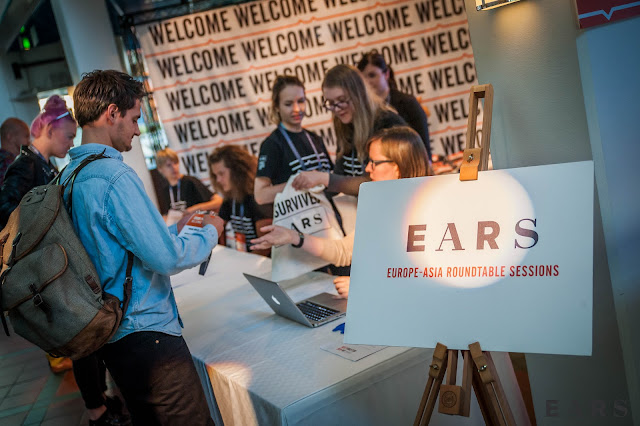I was lucky
to participate in this year's Cartoon Forum event, which was held in Toulouse
on the 15.-18.9.2015.
| Picture taken by Brown Bag Films |
What is
Cartoon Forum? It's a yearly happening where (mostly) European production
companies are pitching some of the animation series they are developing or
planning to develop. The purpose of these pitches is to attract broadcasting
companies and other potential buyers to invest in the series-in-progress by
pre-sales, and to get coproduction deals with other companies. Well, that is
the main purpose, but many of the visitors of the event were young animators
just out of university, as well as young companies which want to see what kind
of series are being developed. Representatives of media foundations for various
EU countries were also there, watching this year's trends, as well, and of
course networking like everybody else.
Being
there, I took a lot of notes from how the pitches were structured, and listened
keenly what people were saying. I wasn't shy of talking to strange people as
though I've known them for years, because in four short days, it makes no sense
just to wait for someone to introduce you to interesting people. And being over
40 means to me that I'm not as afraid of making myself ridiculous in public as
before - partly because I think everyone over 40 is a bit ridiculous anyway.
 |
| Typical street view from Toulouse |
What were
the trends, then, with animated series? Well, I noticed that there were a lot
of series for very young children, meaning age groups 0-1, 2-3, 3-5. And yes,
the age groups are quite tight when you talk of kids programming. School kids
also got their fair share of shows, but there weren't that many proposals of
series for younger or older teenagers, partly because the older kids already
watch stuff in the internet, or programming intended for young adults such as
sitcom series.
That said,
many school kids' series also used a kind of mini sitcom structure, or at least
sitcom-like elements. You know, the kind of show where there's a recurring cast
of characters, often friends or family members, and funny situations arising
from the differencies of these characters. Many shows combined this with
fantasy or science fiction elements.
Sometimes,
when I ask students on our animation courses to generate ideas for animated
series for children, some people come straight away up with some educative
content. But usually it's a good idea not to have the educational elements jump
on your audience's face, so to say. Children are smart - they usually know when
an adult is trying to preach or teach them something, and they get enough of
that in school.
| Interstellar Ella by Zooper Film |
There were
a few show concepts at Cartoon Forum with educational content, too, such as Interstellar Ella, which is a story of an 8-year-old girl and her little sister
who go to adventures in space. The log line for that was "Astrophysics for
preschoolers!" Then there was Dougie Noir, a 9-year-old circus boy who
wanted to be a great detective - only his hyperactive nature prevents him of
noticing important clues for solving the mysteries. Dougie Noir had a package
of apps and games designed to train kids with attention deficit disorders, so
that they wouldn't need to take so many pills.
Also a Finnish-Norwegian concept
called Little Wild Worlds was an animated nature documentary, showing real
behaviours of baby animals, and there was a Korean show about a cute little
gardener mole called Rabby, which showed how to grow real plants. (There were
many broadcasting company representatives at the latter one's pitching, and it
got deals made from all of them. "It's Rabby's golden harvest day",
said one producer from a Korean broadcasting company.)
| Rabby, by PniSystem & From EAST(SKR) |
Some shows
were a bit preachy in tone, I have to admit, but at the other end, there were
shows that were just very full of super cute little kids or animal characters
dancing and jumping around super enthusiastically, with sugary music. It's as
if some of makers of the little kids' shows have never been around small
children, or they don't remember what it was like to be a small child.
| Lili, by Dansk Tegnefilm and Ladybird Films |
This was
not the case with the series Lili, which depicted quite realistically -
with ironic undertones - what 3-year-olds are really like. The Lili books are
already popular and famous, so I guess that the animated show will have no
problems lifting off.
| The Ogglies, by Wunderwerk |
The same goes for the German show called The Ogglies,
where there also are several popular books and apps published in many languages already.
The Ogglies' log line was "A family of space alien Pippi Långstrumps are
living in a local dump, eating trash and having fun". Also a show I wish
to see when it's ready.
| Blaise, by KG Productions |
One show for young adults called Blaise consisted of 30
3-minute web episodes, and the humor was quite harsh but very funny at the same
time. Blaise was based on some popular books for teenagers. A show called
Dickie was aimed at over 14-year-olds, and it had a simple main character who
always screwed things up. Dickie was based on the popular Dutch comic series Boerke, and
at the presentation, they even handed out small booklets of the comics.
 |
| Dickie or Boerke, a comic by Pieter de Poortere |
At a few
pitchings the audience got little gifts, such as bags, leaflets and fun stuff
such as sketch books (I got one from an Italian show called Bestiacce) or large
picture books (some guy gave me one called Blue Carrot). It’s not a bad way to
make your show remembered, providing that the content of your concept itself really
is good. It would be kinda sad for a producer to see their promotion material
spread all over the event center, as no-one would want to pick it up or take it
home.
 |
| Bestiacce, by Studio Bozzetto |
It seemed
to me that if a production company already has acquired rights to some well-known
property, even to an older series made in the 1970s or ‘80s, it’s easier to get
an animated series based on that funded, than make up a new series from
scratch. Many or most of the projects presented had a full transmedia palette
as well, with well-thought-out apps, books, games and websites, and of course
merchandizing such as dolls, towels, school equipment and backpacks. If a
series was for instance 26 x 11 minutes for television, it often had a 52 x 1
minute web series as a companion, as well.
The
distributors I talked with said that right now, there is a demand for new,
comedy-filled series for school children in the age groups 7-9 and 9-11. One
lady told me that there may be a come-back for the longer, 22-minute per
episode series, as well, although most of the series that were presented had
11-minutes, 13-minutes or 7-minutes episodes. Of course, producing a show with
26 episodes of 22 minutes is quite demanding, as writing longer episodes often takes
more time in re-writes, and the animating itself is also not exactly cheap. It
remains to be seen how much emerging technologies, such as using motion capture
for both 3D and 2D, will change the animation landscape.
There are
other big animation events in Europe during the year besides Cartoon Forum,
such as Cartoon Movie, where animated feature films in development are
presented, or the prestigious MIFA in Annecy, in the middle of June. MIFA is a
very large happening, I’ve been told, with lots of movie screenings, seminars,
key notes and a film market, but some producers are saying that it’s become too
big and noisy a place to make any real negotiations anymore. Even Cartoon Forum
now had over 900 participants, which made some of the popular pitchings and
evening events quite crowded.
| MIFA, at Annecy |
A student
can participate MIFA in Annecy for a low price, or even for free if willing to
work for the festival, and I’ve been thinking that Annecy might be a good event
to go with a group of students. Only its timing is not ideal for the Finnish
university year, where most students are working in June and July. Cartoon
Forum may be better time-wise. When the new animation minor starts next year,
it would make sense to go to some of these events with students, the way we go
to other places such as the Graz EYA Awards in October and the Malmö Nordic
Game Conference. Provided of course that enough of our media students would be
interested in going. At least I think it would be a good experience for a
student to see that there is a lot of animation done outside of the video games
world, and that producing animated series and movies is quite a large business
in the media world.
-- Text by Carita Forsgren, 2015 --

 Suomeksi
Suomeksi
























